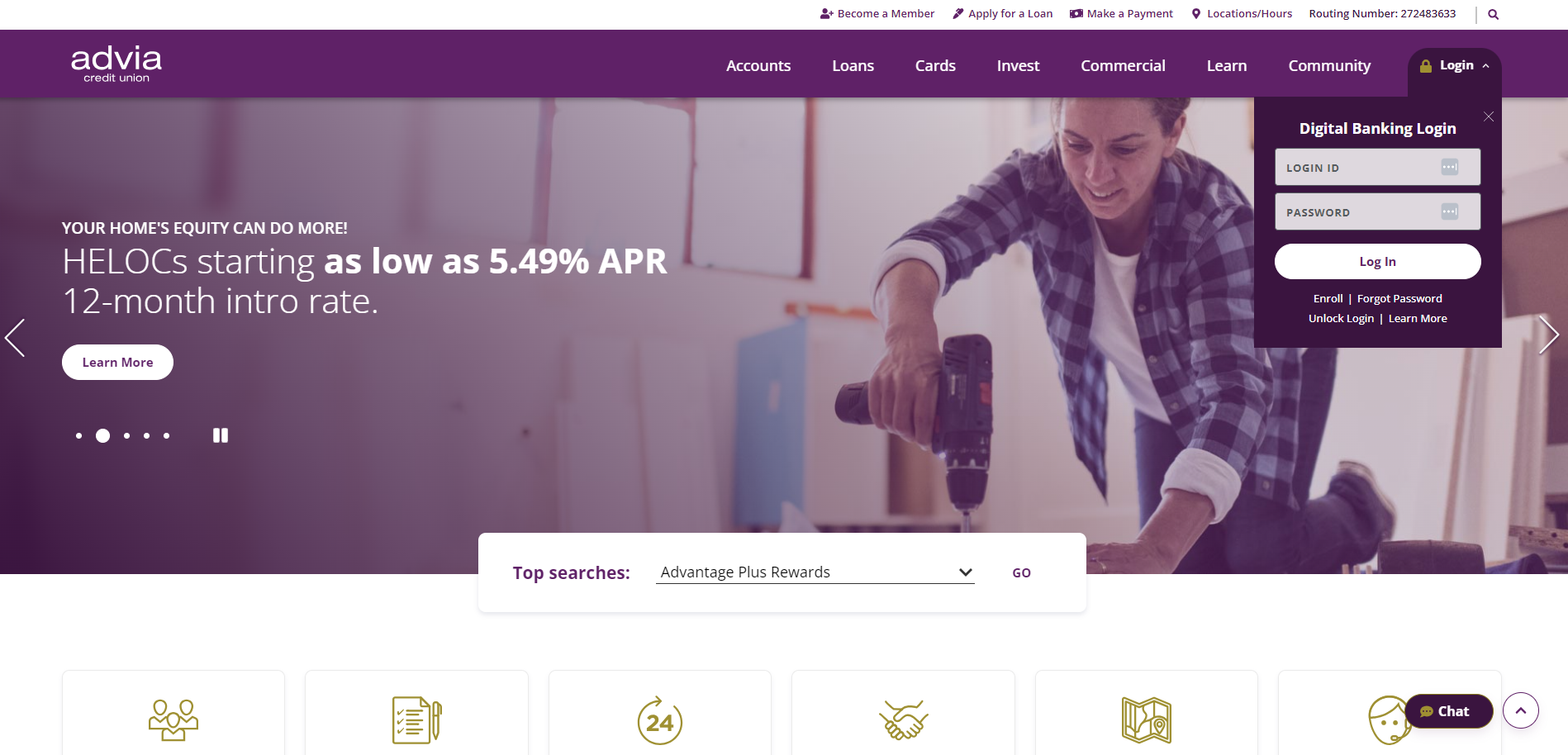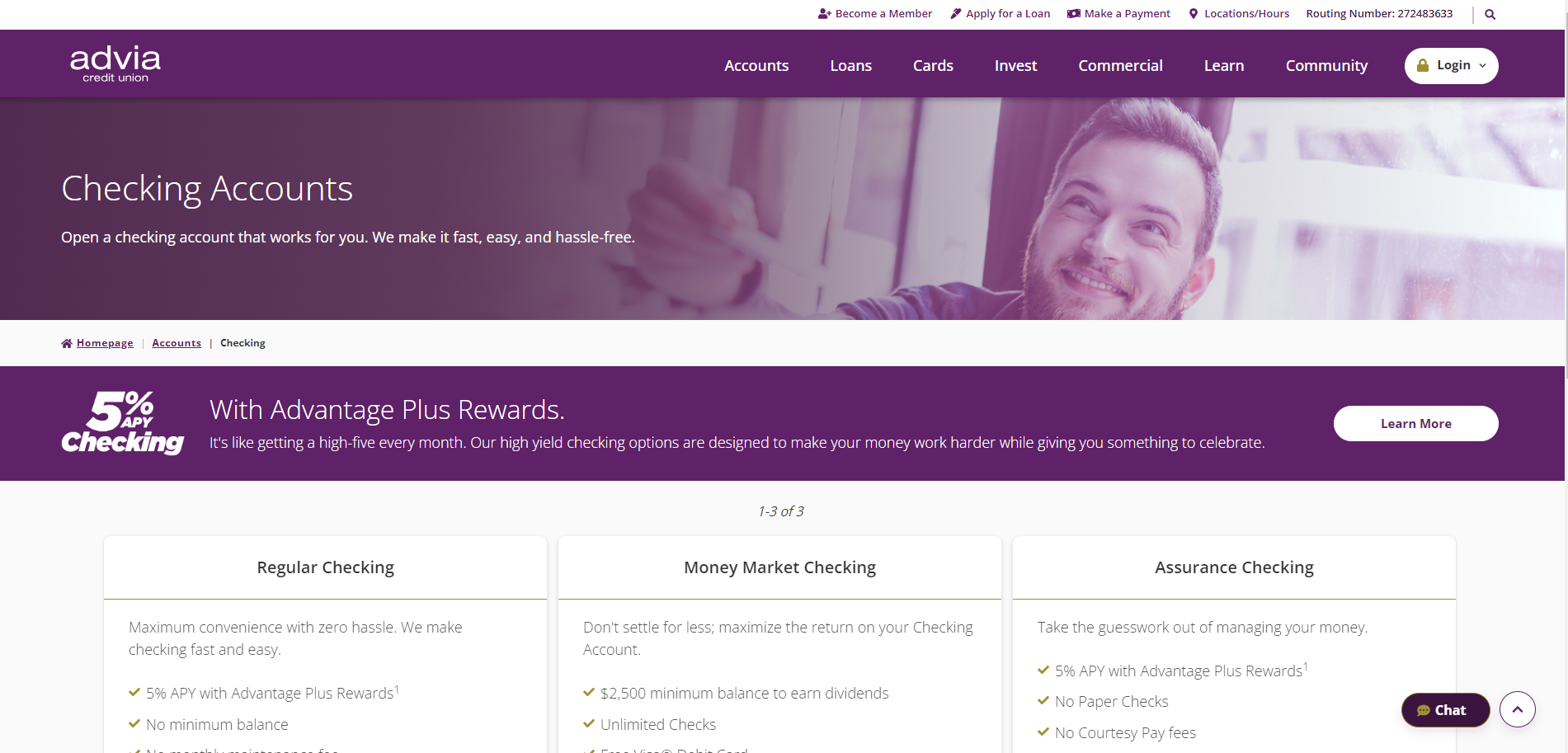ADVIA CREDIT UNION
Services we provide:
- Discovery
- Digital Strategy
- Content Analysis
- Custom Integrations
- UX/UI Design
- Website Development
- Hosting
- Support
About Advia Credit Union
Advia Credit Union has a mission to provide financial advantages to its members by providing advice, advocating for members, and offering advantages other financial institutions don’t. This is accomplished through innovative financial solutions and a new, scalable website. For this new site, Advia sought to proactively provide the quickest and easiest digital solution for members to get the best user experience. Advia is not like other financial institutions; this is illustrated in Advia’s commitment to serving the ever-changing financial needs of its members. One of its core values is to drive progress by engaging in a spirit of innovation and developing new digital service tools for its members. This led to an innovative website redesign to give members easy access to information digitally.
The Challenge
The old website was not intuitive, and the overall digital experience lacked. The lending areas of the old site for both mortgages and auto loans were not producing results. With increased in mobile traffic, the site needed an improved mobile user experience. A major challenge facing Advia’s business team was the organization and content hierarchy of the old site. The content was repetitive and text-heavy, and members were confused about where to find the information they sought. Other obstacles included Advia’s team being unable to easily update the content and structure of the pages on the old website.
Goals for the New Site:
- Improved navigation layout
- Measurable enhancements
- Increase time spent on the website
- Meets brand standards with redesign
- Increase overall visitors engagement
- Increase content management efficiency
Advia wanted to create a “one-stop” resource center to educate members on digital banking—including forms, links, documents, and video tutorials. Two goals for the new Advia Credit Union website were simplifying content and allowing self-service for members. Advia did not want to reinvent the wheel in terms of UI but wanted to deliver a better digital experience to its members and potential new members. The new website provides a clean and clear navigation experience to eliminate clutter and confusion.
The Right Platform
SilverTech reviewed several CMS/DX platforms with Advia. Progress Sitefinity was the chosen platform, giving Advia a fully optimized digital experience. Using the page templates on the Sitefinity platform allows Advia to accomplish the goals for the new site by enhancing the design and layout of the website with ease. The new website improves the user experience with the use of properly placed navigation buttons and call to actions (CTAs) clearly directing users through the content on the page to the sub-pages. Advia’s site has an engaging navigation and advanced filter functionality allowing users to get to the content they are looking for with ease. Additionally, the Advia content team can seamlessly update and create pages within the Sitefinity CMS, keeping the website current and relevant.
RESULTS
The California Invasion of Privacy Act
By: Paul Creme | 3/19/25
A recent blog post on our website discussed the increase in the number of states that have adopted several types of privacy statutes modeled after the California Privacy Rights Act (“CPRA”).
There is another statute not as well-known and more limited in scope that companies should also be aware of. It is the California Invasion of Privacy Act (“CIPA”). At this time, it may only impact companies that are located within the state of California, but just as the CPRA applies to a resident in the state of California, the CIPA applies as well if the person accessing your website is a resident of California.
The reason for an increase in threatened actions based on the CIPA is that unlike the CPRA, the former allows for statutory damages of $5,000.00 per person. Some of the demand letters not only threaten legal action, but may become class actions suits, thus increasing the amount of damages. A class of a few hundred people could be a significant exposure.
The basis of the potential litigation is an invasion of privacy by using cookies and/or other website tracking technologies on the website. The argument is that these tracking technologies are an unwelcome invasion of a user’s privacy, like eavesdropping on a private conversation.
Numerous third-party applications integrate with websites to monitor, analyze, and optimize user interactions. Tools like Google Analytics and Hotjar track user behavior, session recordings, and engagement metrics to provide insights into website performance. Additionally, social media tracking pixels such as those from Facebook (Meta) and X (formerly Twitter), collect data on user interactions to enable personalized advertising, retargeting, and content optimization. Other analytics platforms, heat mapping tools, and behavioral tracking services further enhance a businesses’ ability to refine user experiences and improve marketing effectiveness. It is crucial to know which platforms will align with your business’s industry regulations such as HIPAA compliance laws.
The main issue under the CIPA is the absence of consent to using tracking technology. The use of a pen register, a “recording’ of the user’s interactions with the website amount, without a court order or explicit consent is illegal.
While the law remains unsettled, it will not stop the possibility of receiving a demand letter from an aggressive law firm, similar to the cases a few years ago about access under the Americans with Disabilities Act demanding that your company settle or face potential litigation.
The question is, what should a company do now to shield itself from a claim, or at least have a viable defense to a claim?
First, review terms of use and privacy policies that specifically deal with the use of website tracking technology with your legal counsel. Second, review how your company handles the information. Go beyond privacy statues and take inventory of what is on your website and determine if there is any tracking technology. Third, determine whether the tracking technology is critical to the operation of the company. If not, think about disabling it. Finally, make sure that opt out language is clear and allows the user to either opt out or block the tracking.
Please note this not intended to be legal advice and we cannot provide the language best suited to your particular company. This is something you need to work on with your legal counsel, but we can assist in evaluating and perhaps minimizing the potential risk. Contact us if you would like to learn more.



